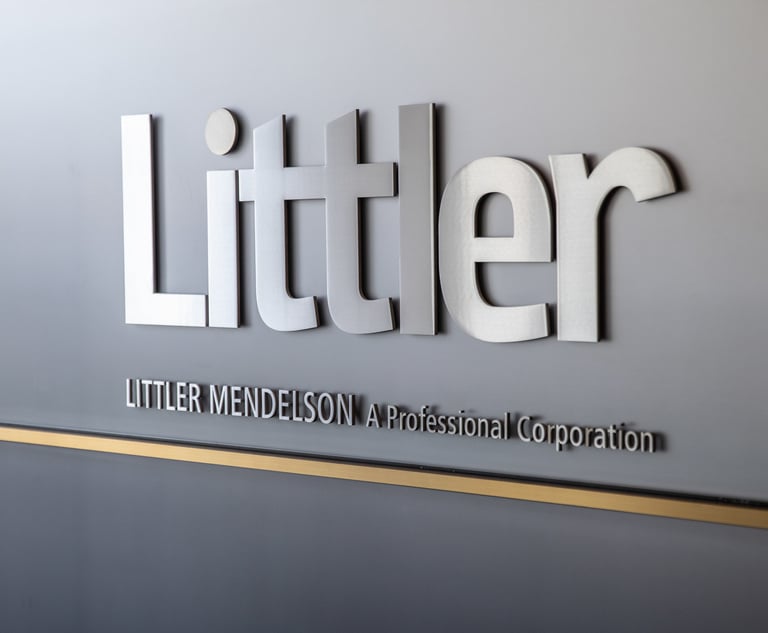A Demand Turnaround for Law Firms? Not for Everyone
In the legal market, it remains true that bigger is better. A new report says Am Law 100 firms significantly outperformed their smaller peers in the first three months of 2018.
May 14, 2018 at 06:45 AM
4 minute read
 Photo: Shutterstock
Photo: Shutterstock
Bigger is better is a tired phrase, but it remains a truism in today's legal market.
Overall, demand for law firm hours in the first quarter of 2018 fell by 0.5 percent, the most since 2013, according to data from Thomson Reuters Corp. But the nation's 100 largest firms saw demand rise, by 0.4 percent, marking the fourth time in the last five quarters that the Am Law 100 was the lone segment of the market to see rising demand.
Separate data released Monday by Citi Private Bank's Law Firm Group also found that demand grew only for the top segment of the law firm market.
See also: The Legal Market Is Looking Up, Citi Q1 Survey Shows
While the Thomson Reuters data show a relatively strong performance among large firms, the drop in demand was nevertheless somewhat of a surprise as it came directly on the heels of one of the strongest quarters for law firm financials since the credit crisis. The first quarter is also historically one of the stronger periods of growth for law firms.
The weak demand performance helped pull down a composite score that Thomson Reuters tracks of law firm health by eight points, to settle at 52. Its rise to 60 in the fourth quarter of 2017 represented a high-water mark that had not been reached since 2011. That metric, called the Peer Monitor Index, tracks relative changes of demand, productivity, rates, direct expenses and overhead expenses.
To be sure, the largest firms are not experiencing the same melancholy market as midsize firms. Demand at Am Law Second Hundred firms declined 0.3 percent and midsize firms saw demand down 1.2 percent, according to the Peer Monitor data. In the first quarter, rates grew 3.3 percent across the cohort of firms tracked by Thomson Reuters, which represented stronger growth than the first quarter for the past two years.
That growth, too, was primarily fueled by the country's largest firms. Rates at Am Law 1 to 50 firms jumped 6.3 percent, which the survey called “remarkable.” Across the Am Law 100, rates were up 4.5 percent from the prior-year period.
“The Am Law 100 continues to separate itself from the pack,” said Michael Abbott, vice president for client management and thought leadership at Thomson Reuters. “And you are seeing some struggles in the Second Hundred, and particularly the second half of the Second Hundred and midsize firms, which is having an impact on the overall peer monitor numbers.”
➤➤ Want more reporting on the evolving legal industry? Sign up here for The Law Firm Disrupted, offering an in-depth, levelheaded discussion of trends rocking the legal sector.
The Am Law 50 may have felt comfortable pushing rate increases in the first quarter after seeing a spike in demand and rates in the fourth quarter of last year, said Justin Hines, a senior analyst at Thomson Reuters. Those firms working on major matters still have the ability to set their prices, even as many analysts of the legal market describe a buyer's market for commoditized work.
“There is the potential that the fourth quarter gave them confidence to push that rate. It's certainly not something we've seen,” Hines said of rate growth as high as 6.3 percent. “If that continues to be the trend, it will be an interesting story throughout 2018.”
As rates increase, realization will be a figure to watch. In the first quarter, it remained fairly steady at 88.1 percent. But realization in this quarter does not necessarily correlate to the high billing rate growth seen over the same timeframe. If that number falls in the second period, it could represent pushback by clients.
“If we continue to see that aggressive rate growth, hopefully realization will keep pace, but we may see that start to [drop off] in the second or third quarter as the bills actually get paid,” said William Josten, senior legal industry analyst at the Thomson Reuters Legal Executive Institute.
One area in which Am Law 100 firms underperformed other segments was demand for litigation services. Overall, litigation hours dropped 0.9 percent. Second Hundred firms saw demand rise 1.3 percent, however, as their larger competitors saw a decline of 1.7 percent. It was the second straight quarter where litigation demand for the Am Law 100 has lagged behind that of its mostly smaller competitors.
Read More:
Despite Anxiety-Inducing Trends, Am Law 100 Rose to the Challenge in 2017
This content has been archived. It is available through our partners, LexisNexis® and Bloomberg Law.
To view this content, please continue to their sites.
Not a Lexis Subscriber?
Subscribe Now
Not a Bloomberg Law Subscriber?
Subscribe Now
NOT FOR REPRINT
© 2025 ALM Global, LLC, All Rights Reserved. Request academic re-use from www.copyright.com. All other uses, submit a request to [email protected]. For more information visit Asset & Logo Licensing.
You Might Like
View All
Paul Hastings, Recruiting From Davis Polk, Adds Capital Markets Attorney
3 minute read

Three Akin Sports Lawyers Jump to Employment Firm Littler Mendelson

Brownstein Adds Former Interior Secretary, Offering 'Strategic Counsel' During New Trump Term
2 minute readTrending Stories
Who Got The Work
J. Brugh Lower of Gibbons has entered an appearance for industrial equipment supplier Devco Corporation in a pending trademark infringement lawsuit. The suit, accusing the defendant of selling knock-off Graco products, was filed Dec. 18 in New Jersey District Court by Rivkin Radler on behalf of Graco Inc. and Graco Minnesota. The case, assigned to U.S. District Judge Zahid N. Quraishi, is 3:24-cv-11294, Graco Inc. et al v. Devco Corporation.
Who Got The Work
Rebecca Maller-Stein and Kent A. Yalowitz of Arnold & Porter Kaye Scholer have entered their appearances for Hanaco Venture Capital and its executives, Lior Prosor and David Frankel, in a pending securities lawsuit. The action, filed on Dec. 24 in New York Southern District Court by Zell, Aron & Co. on behalf of Goldeneye Advisors, accuses the defendants of negligently and fraudulently managing the plaintiff's $1 million investment. The case, assigned to U.S. District Judge Vernon S. Broderick, is 1:24-cv-09918, Goldeneye Advisors, LLC v. Hanaco Venture Capital, Ltd. et al.
Who Got The Work
Attorneys from A&O Shearman has stepped in as defense counsel for Toronto-Dominion Bank and other defendants in a pending securities class action. The suit, filed Dec. 11 in New York Southern District Court by Bleichmar Fonti & Auld, accuses the defendants of concealing the bank's 'pervasive' deficiencies in regards to its compliance with the Bank Secrecy Act and the quality of its anti-money laundering controls. The case, assigned to U.S. District Judge Arun Subramanian, is 1:24-cv-09445, Gonzalez v. The Toronto-Dominion Bank et al.
Who Got The Work
Crown Castle International, a Pennsylvania company providing shared communications infrastructure, has turned to Luke D. Wolf of Gordon Rees Scully Mansukhani to fend off a pending breach-of-contract lawsuit. The court action, filed Nov. 25 in Michigan Eastern District Court by Hooper Hathaway PC on behalf of The Town Residences LLC, accuses Crown Castle of failing to transfer approximately $30,000 in utility payments from T-Mobile in breach of a roof-top lease and assignment agreement. The case, assigned to U.S. District Judge Susan K. Declercq, is 2:24-cv-13131, The Town Residences LLC v. T-Mobile US, Inc. et al.
Who Got The Work
Wilfred P. Coronato and Daniel M. Schwartz of McCarter & English have stepped in as defense counsel to Electrolux Home Products Inc. in a pending product liability lawsuit. The court action, filed Nov. 26 in New York Eastern District Court by Poulos Lopiccolo PC and Nagel Rice LLP on behalf of David Stern, alleges that the defendant's refrigerators’ drawers and shelving repeatedly break and fall apart within months after purchase. The case, assigned to U.S. District Judge Joan M. Azrack, is 2:24-cv-08204, Stern v. Electrolux Home Products, Inc.
Featured Firms
Law Offices of Gary Martin Hays & Associates, P.C.
(470) 294-1674
Law Offices of Mark E. Salomone
(857) 444-6468
Smith & Hassler
(713) 739-1250










